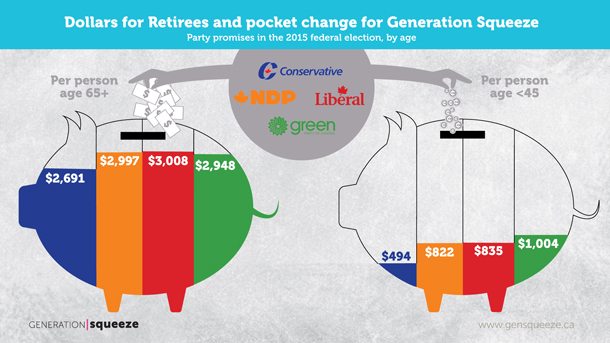
Many Canadians will be surprised to learn that the middle class tax cut Liberal leader Justin Trudeau keeps talking about is not for them.
"Nine in 10 Canadians think they're going to benefit, because nine in 10 Canadians think they're the middle class," said Paul Kershaw, a University of British Columbia professor in the school of population and public health and the founder of the advocacy group Generation Squeeze.
While Liberal advertising, talking points and press releases promise a tax cut to help the middle class, they seldom define who would benefit.
For that, one needs to turn to the party's 88-page platform released last week, which spells out that the 1.5 per cent decrease in the tax rate applies only to taxable individual incomes of between $44,700 and $89,401.
That means to see the maximum tax cut of $1,340, a household would have to have two earners at the top of the income bracket, or a household income of nearly $179,000. On the other hand, anyone making less than $44,700, which is most people, would see no benefit at all.
As the NDP pointed out in a press release, the Canada Revenue Agency's figures for 2012, the most recent available, show that 67.5 per cent of taxpayers earned less than $45,000. Put another way, nearly seven out of 10 taxpayers wouldn't benefit from the Liberals' proposed tax cut.
The NDP also noted the irony of Trudeau promoting the plan at a campaign stop at a Toronto grocery store, an industry where the average annual salary is around $22,000.
A Statistics Canada table shows that for individuals in Canada in 2013, the median total income -- the amount that half of all people earned above and half under -- was $32,020.
Opportunistic pitch
Kershaw called the Liberal pitch to the middle class "opportunistic," and said the discussion ties into a debate about whether or not the middle class is doing worse or better than it did a decade ago.
While one side says the middle class has never been better off and the other says they're struggling, the question really depends on taking a closer look at who is doing well and is doing poorly in today's economy.
"The middle class is breaking down along age lines," Kershaw said. "A tax break will be too blunt to address that."
While the country has successfully reduced seniors' poverty in recent decades and real estate gains have swelled the net worth of longtime property owners, younger people are doing worse as a group than they were a generation ago, he said. The challenges include a job market with stagnant wages, escalating home prices and student debt taken on in pursuit of an education.
The Liberals, and the other parties should be tuning their pitches to better address the generational discrepancy, Kershaw said.
Kershaw recently crunched the numbers from the platforms of the four main parties to compare them from a generational standpoint. He presented his findings in By the Numbers: A generational guide to voting in the 2015 federal election.
"There's a dizzying array of dueling promises made by parties," he said. "For the average voter it's impossible [to compare]. That's what this report is really designed to be about."
'Pocket change' for younger Canadians
Kershaw found all four parties were committed to protecting spending on retirees, even as the population of seniors in Canada swells. In comparison, he said, "All parties invest pocket change in younger Canadians."
The Conservatives would spend the least per person over the age of 65 at $2,691, while the Liberals were the highest at $3,008, just slightly above the NDP and Greens. A big part of the spending is for health care, a system disproportionately used by older Canadians, which all the parties would maintain.
Per person under the age of 45, the Conservatives would spend $494, the NDP $822, the Liberals $835 and the Greens $1,004, according to Kershaw's report.

None of the parties is offering much of a plan to address high housing prices, a major driver of the generational divide in big cities including Vancouver and Toronto, he said. "There's little talk in the platforms about how to resolve that issue."
Each of the parties has its strengths, he said, crediting the Liberals for their plan to invest in infrastructure, the NDP for its plans to provide $15-a-day childcare and increase spending on Employment Insurance, and the Conservatives for efforts to control spending on health care.
But the Greens stood out for their focus on younger people, he said. They were the only party talking about student debt and they have a plan to create a youth service corps to provide job experience.
Among the other three there was much similarity, and little imagination on what would be possible to support young people, he said.
Kershaw pointed out that the Conservatives plan to collect less tax than the others, so will have less to spend. But while they would spend 10 per cent less than the other parties on retirees, their spending on young people would be 40 or 50 per cent lower.
Even people likely to benefit from Conservative tax cuts might be unhappy that their gain would be at the expense of their children and grandchildren, Kershaw said. "That's a louder conversation we have to have in this country." ![]()
Read more: Politics, Federal Politics, Election 2015















Tyee Commenting Guidelines
Comments that violate guidelines risk being deleted, and violations may result in a temporary or permanent user ban. Maintain the spirit of good conversation to stay in the discussion.
*Please note The Tyee is not a forum for spreading misinformation about COVID-19, denying its existence or minimizing its risk to public health.
Do:
Do not: